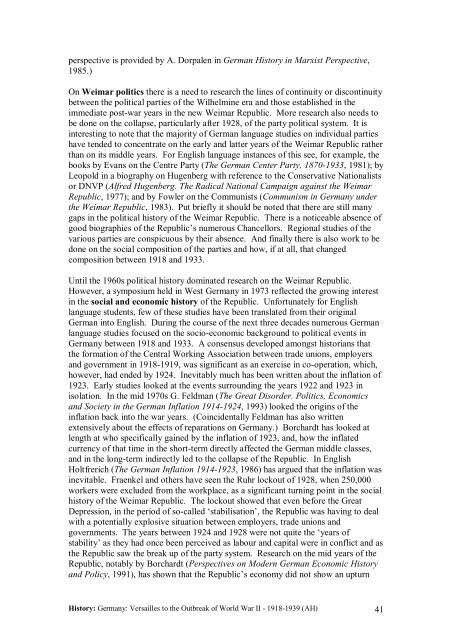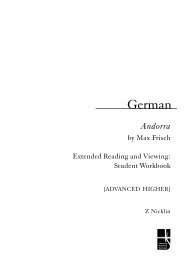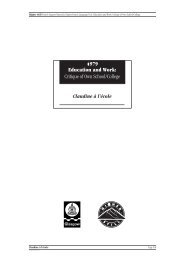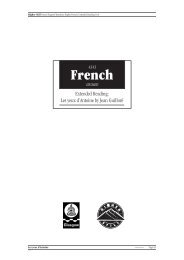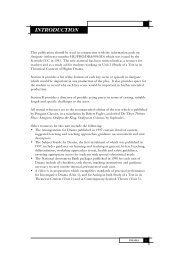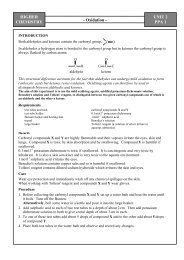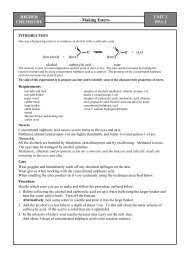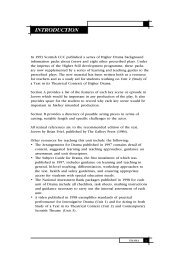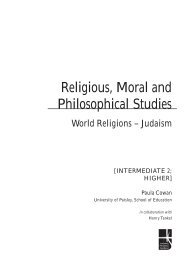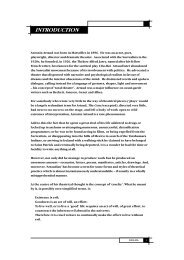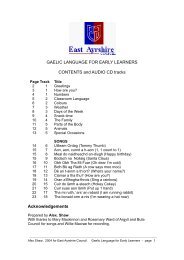PDF file: History - Advanced Higher - Germany - Education Scotland
PDF file: History - Advanced Higher - Germany - Education Scotland
PDF file: History - Advanced Higher - Germany - Education Scotland
You also want an ePaper? Increase the reach of your titles
YUMPU automatically turns print PDFs into web optimized ePapers that Google loves.
perspective is provided by A. Dorpalen in German <strong>History</strong> in Marxist Perspective,<br />
1985.)<br />
On Weimar politics there is a need to research the lines of continuity or discontinuity<br />
between the political parties of the Wilhelmine era and those established in the<br />
immediate post-war years in the new Weimar Republic. More research also needs to<br />
be done on the collapse, particularly after 1928, of the party political system. It is<br />
interesting to note that the majority of German language studies on individual parties<br />
have tended to concentrate on the early and latter years of the Weimar Republic rather<br />
than on its middle years. For English language instances of this see, for example, the<br />
books by Evans on the Centre Party (The German Center Party, 1870-1933, 1981); by<br />
Leopold in a biography on Hugenberg with reference to the Conservative Nationalists<br />
or DNVP (Alfred Hugenberg. The Radical National Campaign against the Weimar<br />
Republic, 1977); and by Fowler on the Communists (Communism in <strong>Germany</strong> under<br />
the Weimar Republic, 1983). Put briefly it should be noted that there are still many<br />
gaps in the political history of the Weimar Republic. There is a noticeable absence of<br />
good biographies of the Republic’s numerous Chancellors. Regional studies of the<br />
various parties are conspicuous by their absence. And finally there is also work to be<br />
done on the social composition of the parties and how, if at all, that changed<br />
composition between 1918 and 1933.<br />
Until the 1960s political history dominated research on the Weimar Republic.<br />
However, a symposium held in West <strong>Germany</strong> in 1973 reflected the growing interest<br />
in the social and economic history of the Republic. Unfortunately for English<br />
language students, few of these studies have been translated from their original<br />
German into English. During the course of the next three decades numerous German<br />
language studies focused on the socio-economic background to political events in<br />
<strong>Germany</strong> between 1918 and 1933. A consensus developed amongst historians that<br />
the formation of the Central Working Association between trade unions, employers<br />
and government in 1918-1919, was significant as an exercise in co-operation, which,<br />
however, had ended by 1924. Inevitably much has been written about the inflation of<br />
1923. Early studies looked at the events surrounding the years 1922 and 1923 in<br />
isolation. In the mid 1970s G. Feldman (The Great Disorder. Politics, Economics<br />
and Society in the German Inflation 1914-1924, 1993) looked the origins of the<br />
inflation back into the war years. (Coincidentally Feldman has also written<br />
extensively about the effects of reparations on <strong>Germany</strong>.) Borchardt has looked at<br />
length at who specifically gained by the inflation of 1923, and, how the inflated<br />
currency of that time in the short-term directly affected the German middle classes,<br />
and in the long-term indirectly led to the collapse of the Republic. In English<br />
Holtfrerich (The German Inflation 1914-1923, 1986) has argued that the inflation was<br />
inevitable. Fraenkel and others have seen the Ruhr lockout of 1928, when 250,000<br />
workers were excluded from the workplace, as a significant turning point in the social<br />
history of the Weimar Republic. The lockout showed that even before the Great<br />
Depression, in the period of so-called ‘stabilisation’, the Republic was having to deal<br />
with a potentially explosive situation between employers, trade unions and<br />
governments. The years between 1924 and 1928 were not quite the ‘years of<br />
stability’ as they had once been perceived as labour and capital were in conflict and as<br />
the Republic saw the break up of the party system. Research on the mid years of the<br />
Republic, notably by Borchardt (Perspectives on Modern German Economic <strong>History</strong><br />
and Policy, 1991), has shown that the Republic’s economy did not show an upturn<br />
<strong>History</strong>: <strong>Germany</strong>: Versailles to the Outbreak of World War II - 1918-1939 (AH) 41


